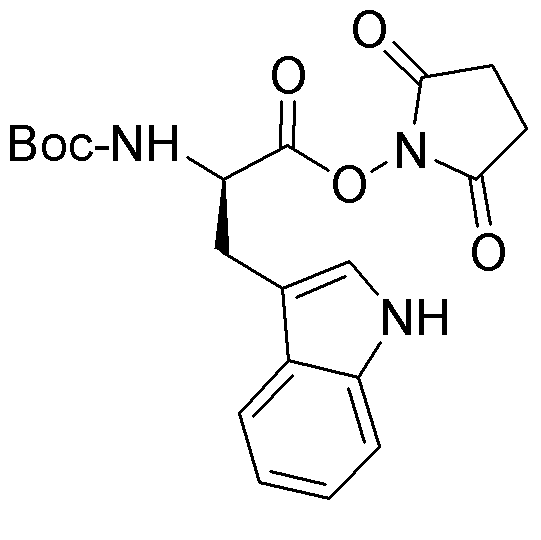Na-Boc-D-tryptophan N-hydroxysuccinimide ester is widely utilized in research focused on:
- Peptide Synthesis: This compound serves as a valuable building block in the synthesis of peptides, particularly those that require tryptophan residues. Its protective Boc group allows for selective reactions, enhancing the efficiency of peptide assembly.
- Drug Development: In pharmaceutical research, it is used to create novel drug candidates by modifying tryptophan's structure, potentially leading to improved therapeutic profiles in areas like cancer and neurological disorders.
- Bioconjugation: The N-hydroxysuccinimide ester functionality facilitates the conjugation of biomolecules, such as proteins or antibodies, to various targets. This is crucial in developing targeted therapies and diagnostic tools.
- Research in Neuroscience: Given tryptophan's role in serotonin production, this compound is explored in studies related to mood regulation and mental health, providing insights into potential treatments for depression and anxiety.
- Material Science: It is also investigated in the development of smart materials that respond to biological stimuli, leveraging its unique chemical properties to create innovative applications in drug delivery systems.
General Information
Properties
Safety and Regulations
Applications
Na-Boc-D-tryptophan N-hydroxysuccinimide ester is widely utilized in research focused on:
- Peptide Synthesis: This compound serves as a valuable building block in the synthesis of peptides, particularly those that require tryptophan residues. Its protective Boc group allows for selective reactions, enhancing the efficiency of peptide assembly.
- Drug Development: In pharmaceutical research, it is used to create novel drug candidates by modifying tryptophan's structure, potentially leading to improved therapeutic profiles in areas like cancer and neurological disorders.
- Bioconjugation: The N-hydroxysuccinimide ester functionality facilitates the conjugation of biomolecules, such as proteins or antibodies, to various targets. This is crucial in developing targeted therapies and diagnostic tools.
- Research in Neuroscience: Given tryptophan's role in serotonin production, this compound is explored in studies related to mood regulation and mental health, providing insights into potential treatments for depression and anxiety.
- Material Science: It is also investigated in the development of smart materials that respond to biological stimuli, leveraging its unique chemical properties to create innovative applications in drug delivery systems.
Documents
Safety Data Sheets (SDS)
The SDS provides comprehensive safety information on handling, storage, and disposal of the product.
Product Specification (PS)
The PS provides a comprehensive breakdown of the product’s properties, including chemical composition, physical state, purity, and storage requirements. It also details acceptable quality ranges and the product's intended applications.
Certificates of Analysis (COA)
Search for Certificates of Analysis (COA) by entering the products Lot Number. Lot and Batch Numbers can be found on a product’s label following the words ‘Lot’ or ‘Batch’.
Numéro de catalogue
Numéro de lot/série
Certificates Of Origin (COO)
This COO confirms the country where the product was manufactured, and also details the materials and components used in it and whether it is derived from natural, synthetic, or other specific sources. This certificate may be required for customs, trade, and regulatory compliance.
Numéro de catalogue
Numéro de lot/série
Safety Data Sheets (SDS)
The SDS provides comprehensive safety information on handling, storage, and disposal of the product.
DownloadProduct Specification (PS)
The PS provides a comprehensive breakdown of the product’s properties, including chemical composition, physical state, purity, and storage requirements. It also details acceptable quality ranges and the product's intended applications.
DownloadCertificates of Analysis (COA)
Search for Certificates of Analysis (COA) by entering the products Lot Number. Lot and Batch Numbers can be found on a product’s label following the words ‘Lot’ or ‘Batch’.
Numéro de catalogue
Numéro de lot/série
Certificates Of Origin (COO)
This COO confirms the country where the product was manufactured, and also details the materials and components used in it and whether it is derived from natural, synthetic, or other specific sources. This certificate may be required for customs, trade, and regulatory compliance.


